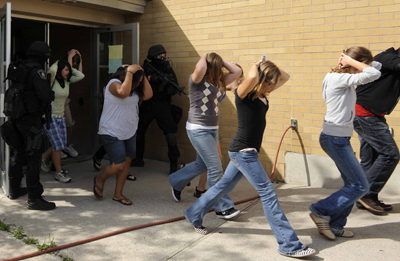Canadian Mennonite
Volume 12, No. 20
Oct. 13, 2008
Violence issues come to class
Mennonite educators frustrated over media coverage as attempts at violence-reduction lead to unwanted exposure
Kitchener, Ont.
 |
For the second time in little over a year, a Waterloo area Mennonite institution has found its participation in a violence-reduction effort played out by the media in unexpected ways.
In late August, Rockway Mennonite Collegiate in Kitchener was the location for a training video production by the Canadian Distance Education Institute (CDEI) to help teachers and administrators respond appropriately in the case of a violent intrusion on a high school campus. A photo of SWAT team members at the Mennonite school in full gear and carrying assault rifles—and a student (portraying a victim of school violence)—was plastered across the local paper’s pages.
In May 2007, Conrad Grebel University College hosted a Shia Muslim-Mennonite dialogue in conjunction with Mennonite Central Committee, whose opening night public discussion was attended by protestors from Toronto. Local media and Canadian Mennonite coverage included photos of Special Weapons and Tactical (SWAT) team members on the roof of the college.
Of the most recent event, Rockway principal Terry Schellenberg says, “I felt very uncomfortable with what I deemed to be the narrow and sensationalist press that emerged from the rehearsal. It did not reflect the holistic sense of how I see this initiative in its broader scope.”
Schellenberg had hoped for coverage that reflects Rockway’s “holistic instruction on all aspects of violence-prevention—including everything from how to manage a critical incident well … to how to develop peer-mentoring and conflict resolution programs.”
Schellenberg notes that “the relationship between a school with a strong peace commitment and the use of the police . . . is challenging and complex, and it gets messy in my own mind.”
“What does it mean to be ‘in the world but not of the world,’ in a situation such as this?” he wonders.
In response to questions from the Rockway constituency, parents and Mennonite Central Committee Ontario generated by the coverage, Schellenberg says that “Rockway is planning to shape a series of chapel forums for our teachers and students that open again our peace commitment, along with a number of these challenging questions from a range of perspectives.”
Steve Brnjas, one of the pastors at Bethel Mennonite Church near Elmira, Ont., and a former Waterloo Regional Police officer, welcomes such efforts. “There is a need for an ongoing discussion on this,” he says, “not just at the theological level but at the reality level, including the reality of policing, which is unwelcome to most Mennonites—a deep discussion on the interaction of peace and violence. . . . Mennonites feel very uncomfortable with Jesus’ [violent] actions in the temple.”
Glen Woolner, former development director at Rockway and part owner of CDEI, had to work hard to convince the various media that covered the video shoot what the scene at Rockway was really about. This was repeated in the following days, when he was interviewed in regard to actual armed incidents and school lockdowns first in Toronto and then in Finland (where 10 students were killed before the gunman committed suicide).
Working to create curriculum based on “intelligent awareness,” planning and thinking ahead, using values of peace and justice, Woolner says CDEI is trying to help schools “create community and make sure everyone has a meaningful place in the community.”